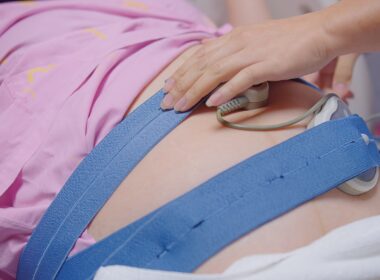If you’ve ever heard the term “uterine fibroids,” it’s likely because the condition runs in your family (or you work in the gynecology field). As common as these non-cancerous tumors are, they often go undetected. If uterine fibroids do run in your family, you may be wondering how to tell if you have them, or if there is a way to decrease your risk of developing them. And if you or a loved one have already been diagnosed with fibroids, you’re likely considering your treatment options. You may also wonder if this diagnosis could impact your fertility.
What are uterine fibroids, and how can they be diagnosed?
Uterine fibroids, also known as uterine leiomyomas, are non-cancerous or benign tumors that grow within the myometrium (muscle layer) of the uterus (womb). Sizes of fibroids range from the size of a pea, all the way up to the size of a grapefruit. Fibroids are different from uterine polyps, which grow in the endometrium, the inner lining of the uterus which we’ve previously referred to as the “wallpaper of the womb.”
Uterine fibroids are very common in American women, affecting up to 70% of women before the age of 50, and substantial percentages of women in other countries experience them as well. While research hasn’t pinpointed a specific cause of fibroids, according to Johns Hopkins Medicine:
“Research suggests each tumor develops from an abnormal muscle cell in the uterus and multiplies rapidly when encountering the estrogen hormone, which promotes the tumor’s growth.”
Most fibroids are detected during routine pelvic exams as part of well-woman visits, or via routine ultrasounds during pregnancy.
According to the Cleveland Clinic, there are multiple ways to diagnose fibroids, including via:
- Ultrasound
- Magnetic resonance imaging (MRI)
- Computed tomography (CT) scan
- Hysteroscopy
- Hysterosalpingography (HSG)
- Sonohysterography
- Laparoscopic surgery
What are the symptoms of uterine fibroids?
While most fibroids are asymptomatic, about 30% of women will experience symptoms, and a percentage of those women will have severe symptoms. Signs and symptoms depend on the size and type of fibroids (there are four types, with more info on each here), and may include:
- Spotting between periods
- Long periods
- Painful or heavy periods (over time, consistently heavy or otherwise abnormal bleeding may lead to anemia because of significant blood loss.)
- Pelvic pain
- Low back pain
- Pain with intercourse
- Bladder issues
- Bowel issues
- Infertility
- Issues during pregnancy (more on this, below)
What increases your risk of developing fibroids?
Your risk of developing uterine fibroids increases with age, up to a point. Women in their 30s and 40s are at the highest risk of developing fibroids, and their risk tapers off and decreases as they reach menopause. Compared to white women, black women are significantly more likely to develop fibroids. They are also more likely to develop them earlier in life, and more likely to have severe symptoms.
Fibroids also appear to have a genetic component, as a woman’s risk of developing them is higher if a close female relative has had them. Women with high blood pressure and/or obesity are also at higher risk of developing fibroids. Inflammation in the body, which is impacted in part by diet and lifestyle factors, is also believed to play a significant role [1]. Additionally, hormonal birth control use seems to exacerbate existing fibroids.
What’s the connection between uterine fibroids and hormonal birth control use?
The sex hormones estrogen and progesterone, which are responsible for the female menstrual cycle, appear to play a significant role in the development of fibroids. Estrogen is believed to be the most influential in their growth. It makes sense then, that hormonal birth control (especially combined oral contraceptives, which contain both synthetic estrogen and synthetic progesterone) appears to exacerbate existing fibroids.
While birth control pills may be used as a band-aid for symptoms such as heavy periods, because they cause tiny hormonal spikes every day (rather than the larger cyclical fluctuations of an actual menstrual cycle), they do not reduce or otherwise cure the fibroids themselves.
How can you decrease your risk of developing fibroids?
While certain risk factors are outside your control, you can take specific steps to decrease inflammation in your body.
For instance, you can eliminate or significantly reduce your intake of processed foods, refined sugar, refined carbohydrates (such as white bleached flour as found in pasta, cereals, and white bread), and alcohol. You can proactively increase your consumption of anti-inflammatory foods like green leafy vegetables, cruciferous vegetables like broccoli and bok choy, beta-carotene sources like sweet potatoes and carrots, and whole grains such as millet and oats. Some research suggests that flaxseed (which must be consumed ground in order to reap the nutritional benefits) can regulate estrogen and may even help shrink fibroids.
You can also potentially decrease your risk of developing fibroids by reducing your exposure to endocrine-disrupting chemicals (EDCs), which are often found in household cleaning products, cosmetics, and more, and include “phthalates, parabens, environmental phenols, alternate plasticizers, Diethylstilbestrol, organophosphate esters, and tributyltin” [2].
If you’re using hormonal birth control (which is an EDC itself!) for family planning, consider switching to an evidence-based method of natural family planning or a fertility awareness method. They are highly effective, and there are a variety of methods to choose from to find one that best meets your needs.
What are the treatment options for uterine fibroids?
Treatment for uterine fibroids depends on the size, number, and location of the tumors, the severity of the symptoms, and whether the woman desires to preserve her fertility.
Over-the-counter painkillers are recommended for mild or occasional pain from fibroids. More powerful medications like gonadotropin-releasing hormone (GnRH) agonists are sometimes used very short-term to prevent further growth or shrink fibroids before a surgery [3]. However, significant side effects prevent GnRH agonists from being a realistic long-term treatment option.
According to the Cleveland Clinic, some physicians are beginning to prescribe a new endometriosis medication called Elagolix for women with fibroid-related heavy bleeding. As mentioned before, birth control pills such as progestin-only “mini pills,” combination birth control pills, and even the morning-after pill are sometimes prescribed for fibroid symptom relief, although none of these options will reduce or otherwise cure the fibroids themselves–and all come with their own range of risks and side effects.
Should you get surgery?
Sometimes surgery is needed for women who experience chronic severe symptoms due to their uterine fibroids, but this is typically not an option during pregnancy due to the risk of bleeding and/or preterm labor. The Mayo Clinic reviews the full gamut of surgical treatment options, which range from noninvasive to minimally invasive, to fully invasive as with a hysterectomy, plus a discussion of which surgeries will preserve your fertility if you’re hoping to get pregnant in the future. While most women who have fibroids do not require aggressive surgical treatment, a staggering one-third to half of all hysterectomies are performed because of fibroids [4].
Some programs, such as Gessie Thompson’s “Hope Beyond Fibroids Elimination Program,” seek to treat severe symptoms of fibroids without surgery. In multiple interviews like this one, Thompson states that in her personal experience with fibroids and in her work as a women’s health advocate, she sees fibroids as directly related to estrogen dominance, which in turn is the result of “pollutants, diet, and stress.” Thompson specified that her program’s approach seeks to improve women’s quality of life specifically through “coaching, a nutrition plan, herbal supplements, and exercise.”
Do uterine fibroids affect fertility or pregnancy?
Depending on their size and location, fibroids can impair some women’s ability to conceive or to maintain a pregnancy (as with the submucosal type of fibroids). And, as mentioned above, women who undergo a hysterectomy due to severe fibroid symptoms will no longer be able to conceive. For women who do become pregnant, the U.S. Department of Health and Human Services’ Office on Women’s Health notes that most of the time fibroids alone do not cause a “high-risk pregnancy.” In some cases, though, they do increase the likelihood of the baby being in breech position, preterm delivery (before 37 weeks gestation), placental abruption, labor that fails to progress, and a six-fold increased risk of delivering via Cesarean section (C-section). All of these complications mean increased risk for mother and baby during childbirth and postpartum. Women whose fibroids are discovered during their pregnancy may require more frequent monitoring.
For most women, uterine fibroids go undetected or are simply an annoyance. A small percentage of women, though, experience persistent, severe symptoms, which can affect fertility and pregnancy outcomes. Given the heightened focus on maternal mortality within the United States, and especially among black women who are disproportionately affected by fibroids, one hopes more research will be done on this and other gynecological issues–for which there is currently little but the Pill offered.
References:
[1] Cetin E, Al-Hendy A, Ciebiera M. Non-hormonal mediators of uterine fibroid growth. Curr Opin Obstet Gynecol. 2020 Oct;32(5):361-370. doi: 10.1097/GCO.0000000000000650. PMID: 32739973; PMCID: PMC8314923. [2] Bariani MV, Rangaswamy R, Siblini H, Yang Q, Al-Hendy A, Zota AR. The role of endocrine-disrupting chemicals in uterine fibroid pathogenesis. Curr Opin Endocrinol Diabetes Obes. 2020 Dec;27(6):380-387. doi: 10.1097/MED.0000000000000578. PMID: 33044243; PMCID: PMC8240765. [3] InformedHealth.org [Internet]. Cologne, Germany: Institute for Quality and Efficiency in Health Care (IQWiG); 2006-. Uterine fibroids: When is treatment with hormones considered? [Updated 2020 Mar 24]. Available from: https://www.ncbi.nlm.nih.gov/books/NBK279532/ [4] Stewart EA, Laughlin-Tommaso SK, Catherino WH, Lalitkumar S, Gupta D, Vollenhoven B. Uterine fibroids. Nat Rev Dis Primers. 2016 Jun 23;2:16043. doi: 10.1038/nrdp.2016.43. PMID: 27335259.Additional Reading:
Addressing Our Maternal Mortality Crisis with Fertility Awareness
How an Anti-inflammatory Diet Can Help Balance Hormones
“The Business of Birth Control” Review
Is your doctor not listening to you? What to do when you experience medical gaslighting
3 Simple Tips to Limit Endocrine Disruptors and Balance Hormones Naturally











